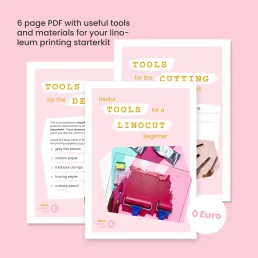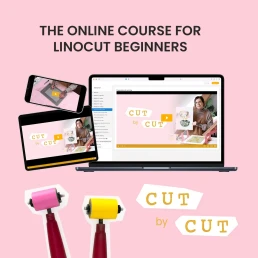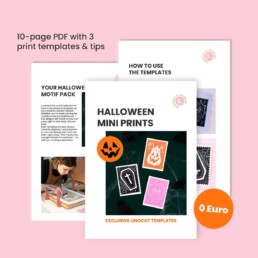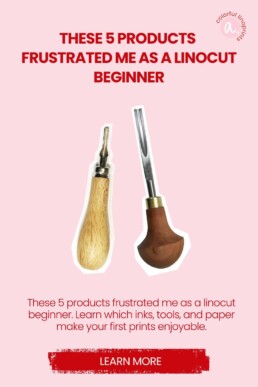
These 5 Products Frustrated Me as a Linocut Beginner
Discover which inks, tools, and paper truly help beginners succeed in linocut. Avoid frustration and enjoy creating your first prints!
I will help you understand linocut printing step by step, try it out for yourself, and create your own prints.
Attention linocut beginners: Some products can cause more frustration than necessary. Learn which materials really help you – and which ones to avoid to stay motivated!
Maybe you know this feeling: when a new hobby excites me, I want to know everything immediately, and I’m so hyped that I just want to start. I watch countless videos and slowly understand the process (or at least I think I do 😄). But when it’s finally time to start myself, questions arise: What should I buy? I don’t want to waste money – who knows if I’ll stick with this hobby?
Often, beginners are tempted to start with cheap products – totally understandable! HOWEVER, I have to admit: some budget supplies backfire. They lead to frustration because they simply don’t work properly. And as a beginner, you can’t always tell whether it’s your technique or the product that’s the problem.
From my experience, some products are fine to save on, but some professional-quality tools are actually much more beginner-friendly than their cheap alternatives.
Here are my top 5 frustrating products for linocut beginners – and better alternatives.
Brayers (Rollers)
Steel-frame rollers are probably the cheapest you can find, while my favorites, Speedball soft rubber brayers, are mid-range. (There are also rollers over €60, which I personally find way too expensive!)
The downside of the steel-frame roller is that it doesn’t handle much pressure. Applying ink with these rollers is uneven, which tempts you to press harder. Uneven ink transfer shows in your print. With practice, beginners can still get decent results with them – but at first, you might get disappointed by prints that are too dark in some areas and too light in others.
Soft rubber brayers are a dream: they distribute ink evenly and smoothly. Cleaning hard rubber rollers is easier, but for me, print quality comes first.
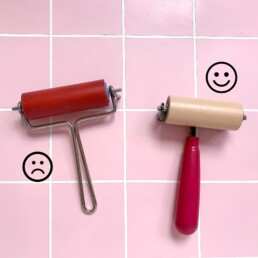
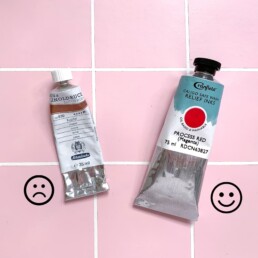
Ink – Water-based or Oil-based?
I started with large tubes of water-based ink, including Schmincke linocut colors. I thought, “A reputable brand, it must be good!” – but I was wrong. The ink sometimes dried while I was printing, and printing in summer heat was a nightmare. I had to apply excessive pressure to get an even result, and eventually, I had to tear the paper off the plate because it had stuck. Frustrating! I didn’t know if it was my fault or the ink.
My answer for linocut beginners: oil-based AND washable ink. You might think oil-based ink means messy cleaning with smelly solvents – fortunately, that’s not the case 😀. Caligo Safe Wash Relief Ink from Cranfield is amazing: excellent print quality, yet easily washable with water and soap.
Carving tools
Again, my credo: don’t skimp on the wrong tools! A set with three different blade sizes covers many functions and is perfect for beginners. I used a cheap interchangeable blade set during university – a nightmare! Combined with a hard, old linoleum block, it ruined my enjoyment. Carving should be meditative and relaxing.
Sharp blades are safer for beginners too: they reduce the risk of slipping. Cheap blades require more control and experience to get good results. Investing in quality carving tools is worth it.
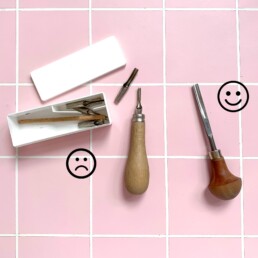
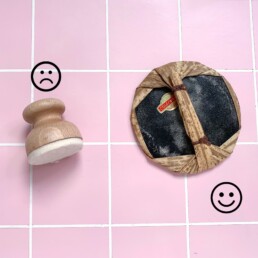
Hand Burnishers
My first hand burnisher wasn’t suitable for my projects. Felt burnishers might work for small stamp designs, but not for linocut. You can’t build enough pressure.
Instead, this Japanese hand burnisher works perfectly! It’s mainly for the first press, then you can switch to a wooden spoon. Still, it’s part of the routine and essential for good results.
Paper – Here You Can Save
Fancy watercolor or heavy 300 gsm paper looks luxurious, but for beginners printing by hand, it’s not ideal. Heavy, textured paper requires more pressure and patience to achieve even results – often frustrating for new linocut beginners.
Smooth, lighter paper around 130–180 gsm is easier to print on and delivers clean results quickly. My personal favorite is 160 gsm design offset paper – similar to what’s sold as cartridge paper.
Paper choice is personal, though. Heavy, textured papers can beautifully enhance single-color or floral designs. For beginners, however, choose easy-to-print paper first, then experiment as you gain experience.
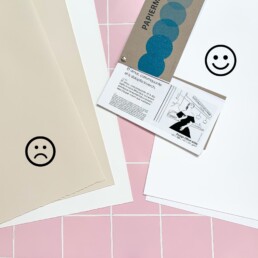
Why Good Materials Are Worth the Investment
Bad prints are frustrating. While trial and error is part of learning, beginners need small successes to stay motivated. The wrong products can quickly ruin your enjoyment. Poor ink coverage or uncomfortable tools can make you give up on printing.
It’s understandable to want to save money at first. But investing in a few high-quality inks and tools makes your start so much easier – and you can always resell them later if you want to try something else.
👉 Want to know which products are truly worth it for linocut beginners? Download my free PDF tool list. If you want to start right away: in my online course, I show you step by step how to create your first multi-color linocut print – frustration-free, fun, and successful! 🥳

